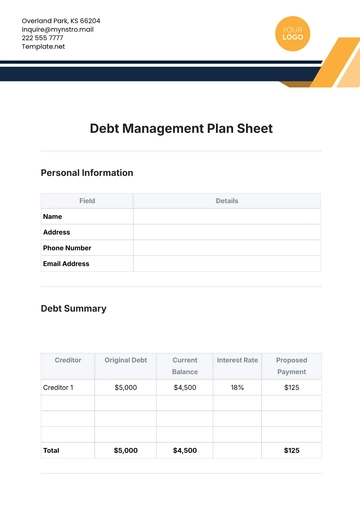Free Finance Mergers & Acquisitions Balancing Plan

I. Objective Statement
The main objective of this plan is to devise key strategies and actions necessary to achieve successful financial mergers and acquisitions (M&A). These strategies should support the full integration of both merging entities, optimizing operational synergies and shareholder value.
II. Pre-acquisition Assessment
In this stage, a detailed evaluation of potential targets will be conducted, focusing on the financial health, market position, and growth potential of the target company. This stage also includes a comprehensive risk assessment, which involves analyzing the deal's likely impact on finances and operational aspects of both entities involved.
III. Financial Valuation
The Financial Valuation stage involves a rigorous assessment of the target entity's current assets, liabilities, cash flows, and the valuation of intangible assets. This detailed financial analysis will help in determining the fair value of the company and a suitable purchase price.
IV. Due Diligence
The due diligence phase ensures transparency and provides in-depth insight into the potential acquisition. It covers investigating the target's company relationships, client base, intellectual property, and potential legal or regulatory risks.
V. Finance Structure and Negotiation
The financial structuring involves deciding upon the preferred mode of financing the deal – cash, stock, or a combination of both. Here, negotiation strategies will be determined which will aim to secure the best possible deal for all parties concerned.
VI. Integration Planning
Prior to closing the deal, a thorough integration plan should be established. It should cover areas such as organizational structure, alignment of business objectives, technology integration, cultural compatibility, and communication plans to all stakeholders.
VII. Regulatory Compliance
M&A activities are subject to different regulatory bodies, presenting a complex legal landscape to navigate. Ensuring full regulatory compliance is vital and includes considerations like antitrust regulations, tax laws, accounting standards, and industry-specific norms.
VIII. Post Merger Integration
Once the deal is closed, the execution of the pre-determined integration plan takes place. This involves combining operations, aligning corporate culture, streamlining workflows, integration of technological systems, and achieving operational synergies.
IX. Performance Monitoring
Post-integration, the performance of the merged entity must be closely monitored. This involves tracking financial metrics, operational efficiencies, market performance, and growth potential against the pre-defined goals and objectives.
X. Risk Management
The final phase involves continuous risk monitoring and management. This includes identifying new risks, implementing strategies to mitigate these risks, and taking corrective action to manage unexpected challenges as they arise.
XI. Next Steps
Immediate next steps involve securing financing, engaging in thorough due diligence, and initiating detailed integration planning. Key responsibilities have been assigned to designated teams and individuals, as detailed in the appendices.
It is crucial to maintain flexibility and adaptability throughout this process. The M&A landscape is dynamic, and unforeseen challenges may arise. As such, our plan includes periodic reviews and checkpoints to assess progress and make necessary adjustments. This will involve close collaboration between the leadership teams of both companies, ensuring clear communication and decision-making alignment. We also plan to engage external advisors to provide expertise in specific areas, such as cross-border regulatory issues or specialized market analysis, to supplement our internal capabilities. This holistic approach will help us navigate potential hurdles and capitalize on opportunities as they arise, ensuring the long-term success of the merger/acquisition.
Prepared By: [Your Name]
Date: [Current Date]
- 100% Customizable, free editor
- Access 1 Million+ Templates, photo’s & graphics
- Download or share as a template
- Click and replace photos, graphics, text, backgrounds
- Resize, crop, AI write & more
- Access advanced editor
Presenting the Finance Mergers & Acquisitions Balancing Plan Template from Template.net. This professional template is crafted to assist in creating balanced strategies for M&A activities. It is fully editable and customizable, catering to specific business scenarios, and ensures a well-rounded approach to planning and executing finance mergers and acquisitions.
You may also like
- Finance Plan
- Construction Plan
- Sales Plan
- Development Plan
- Career Plan
- Budget Plan
- HR Plan
- Education Plan
- Transition Plan
- Work Plan
- Training Plan
- Communication Plan
- Operation Plan
- Health And Safety Plan
- Strategy Plan
- Professional Development Plan
- Advertising Plan
- Risk Management Plan
- Restaurant Plan
- School Plan
- Nursing Home Patient Care Plan
- Nursing Care Plan
- Plan Event
- Startup Plan
- Social Media Plan
- Staffing Plan
- Annual Plan
- Content Plan
- Payment Plan
- Implementation Plan
- Hotel Plan
- Workout Plan
- Accounting Plan
- Campaign Plan
- Essay Plan
- 30 60 90 Day Plan
- Research Plan
- Recruitment Plan
- 90 Day Plan
- Quarterly Plan
- Emergency Plan
- 5 Year Plan
- Gym Plan
- Personal Plan
- IT and Software Plan
- Treatment Plan
- Real Estate Plan
- Law Firm Plan
- Healthcare Plan
- Improvement Plan
- Media Plan
- 5 Year Business Plan
- Learning Plan
- Marketing Campaign Plan
- Travel Agency Plan
- Cleaning Services Plan
- Interior Design Plan
- Performance Plan
- PR Plan
- Birth Plan
- Life Plan
- SEO Plan
- Disaster Recovery Plan
- Continuity Plan
- Launch Plan
- Legal Plan
- Behavior Plan
- Performance Improvement Plan
- Salon Plan
- Security Plan
- Security Management Plan
- Employee Development Plan
- Quality Plan
- Service Improvement Plan
- Growth Plan
- Incident Response Plan
- Basketball Plan
- Emergency Action Plan
- Product Launch Plan
- Spa Plan
- Employee Training Plan
- Data Analysis Plan
- Employee Action Plan
- Territory Plan
- Audit Plan
- Classroom Plan
- Activity Plan
- Parenting Plan
- Care Plan
- Project Execution Plan
- Exercise Plan
- Internship Plan
- Software Development Plan
- Continuous Improvement Plan
- Leave Plan
- 90 Day Sales Plan
- Advertising Agency Plan
- Employee Transition Plan
- Smart Action Plan
- Workplace Safety Plan
- Behavior Change Plan
- Contingency Plan
- Continuity of Operations Plan
- Health Plan
- Quality Control Plan
- Self Plan
- Sports Development Plan
- Change Management Plan
- Ecommerce Plan
- Personal Financial Plan
- Process Improvement Plan
- 30-60-90 Day Sales Plan
- Crisis Management Plan
- Engagement Plan
- Execution Plan
- Pandemic Plan
- Quality Assurance Plan
- Service Continuity Plan
- Agile Project Plan
- Fundraising Plan
- Job Transition Plan
- Asset Maintenance Plan
- Maintenance Plan
- Software Test Plan
- Staff Training and Development Plan
- 3 Year Plan
- Brand Activation Plan
- Release Plan
- Resource Plan
- Risk Mitigation Plan
- Teacher Plan
- 30 60 90 Day Plan for New Manager
- Food Safety Plan
- Food Truck Plan
- Hiring Plan
- Quality Management Plan
- Wellness Plan
- Behavior Intervention Plan
- Bonus Plan
- Investment Plan
- Maternity Leave Plan
- Pandemic Response Plan
- Succession Planning
- Coaching Plan
- Configuration Management Plan
- Remote Work Plan
- Self Care Plan
- Teaching Plan
- 100-Day Plan
- HACCP Plan
- Student Plan
- Sustainability Plan
- 30 60 90 Day Plan for Interview
- Access Plan
- Site Specific Safety Plan





























